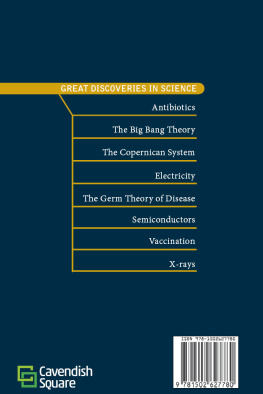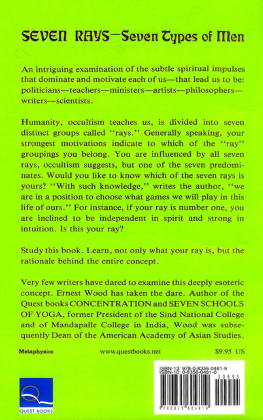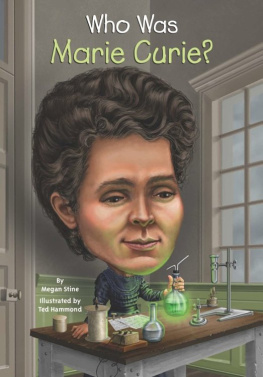GREAT DISCOVERIES IN SCIENCE
X-rays
Kristin Thiel
Published in 2018 by Cavendish Square Publishing, LLC
243 5th Avenue, Suite 136, New York, NY 10016
Copyright 2018 by Cavendish Square Publishing, LLC
First Edition
No part of this publication may be reproduced, stored in a retrieval system, or transmitted in any form or by any meanselectronic, mechanical, photocopying, recording, or otherwisewithout the prior permission of the copyright owner. Request for permission should be addressed to Permissions, Cavendish Square Publishing, 243 5th Avenue, Suite 136, New York, NY 10016.
Tel (877) 980-4450; fax (877) 980-4454.
Website: cavendishsq.com
This publication represents the opinions and views of the author based on his or her personal experience, knowledge, and research. The information in this book serves as a general guide only. The author and publisher have used their best efforts in preparing this book and disclaim liability rising directly or indirectly from the use and application of this book.
CPSIA Compliance Information: Batch #CS17CSQ
All websites were available and accurate when this book was sent to press.
Library of Congress Cataloging-in-Publication Data
Names: Thiel, Kristin.
Title: X-rays / Kristin Thiel.
Description: New York : Cavendish Square, 2018. | Series: Great discoveries in science| Includes index.
Identifiers: ISBN 9781502627780 (library bound) | ISBN 9781502627797 (ebook)
Subjects: LCSH: X-rays--Juvenile literature. | Radiography--Juvenile literature.
Classification: LCC QC481.T45 2018 | DDC 616.07572--dc23
Editorial Director: David McNamara
Editor: Caitlyn Miller
Copy Editor: Michele Suchomel-Casey
Associate Art Director: Amy Greenan
Designer: Lindsey Auten
Production Coordinator: Karol Szymczuk
Photo Research: J8 Media
The photographs in this book are used by permission and through the courtesy of: Cover, p. Cordelia Molloy/Science Source.
Printed in the United States of America
A Transportation Security Administration checkpoint at Salt Lake City International Airport X-rays passengers for weapons.
X-RAYS
Introduction: Changing How We See the World
F rom its humble beginnings as an accidental discovery, the X-ray has come a long way. In 2009, a Science Museum of London poll named the X-ray the most important modern scientific discovery over penicillin, various rocketry, one of the first computers, the first motorized car, and the electric telegraph. It even beat the DNA double helix, which came in number three in the poll of nearly fifty thousand votes. It seems fitting that X-rays took precedence, considering the double helix was found in large part because of Wilhelm Rntgens discovery of the rays!
In 2010, the 115th anniversary of Rntgens work with X-rays was commemorated with a Google Doodle. The search engines name was depicted as a radiograph, and bones and foreign objects, like a swallowed key, were visible within the ghostly shadows of tissue.
The X-ray made itself known to humans through a splashy demonstration for Rntgen, the well-respected but definitely not flashy physics professor in a midsize German city. Rntgen realized that X-rays existed when he saw the bones of his own hand appear on a screen in his laboratory one dark November night in 1895. He wasnt expecting X-rays, but he would be glad theyd shown upthey earned him lasting fame and professional accolades, including a Nobel Prize. Most importantly, they changed our world. Even Rntgen focused on the discoverys applications and not on his individual role in it. He was pleased to be acknowledged for his work, but he refused any major claim on X-rays, saying that such a discovery should not be patented by one but owned by everyone. He may have even found it odd that we call it a discovery, since that places the emphasis on the human. X-rays have always existedits more accurate to say that humans finally came to be able to see them.
Nearly immediately after Rntgens December 28, 1895, announcement of his discovery and the publication of his initial findings, complete with the first two shadowgraphs, scientists and the general public alike found use for the new technology. Surgeons saved more lives on the battlefield by using X-rays to locate bullets, rather than poking their dirty fingers into wounds. In the hospital, they diagnosed kidney stones, saw early signs of tuberculosis, and located the breaks in painful bones. Dentists spotted cavities and cancers. For the first time, researchers saw DNA, lifes instruction manual. X-ray machines found less useful applications, too. They became a frivolity at parties and carnivals, and people chose which shoes they were going to buy after wiggling their toes in a few different pairs in department store fluoroscopes.
In Rntgens time, scientists, medical professionals, and the general public welcomed X-rays with open armseven while admitting that what X-rays were capable of doing was undeniably weird! On January 25, 1896, less than a month after Rntgens announcement that hed discovered X-rays, the British humor magazine Punch published a poem directed at the scientist: O, Rntgen, then the news is true, it began and quickly poked fun at the grim and graveyard humour of his discovery. We do not want, like Dr. Swift, / To take our flesh off and to pose in / Our bones, or show each little rift / And joint for you to poke your nose in.
Yet two years after Rntgen made X-rays public, their health risks came to the fore. Pioneers in X-ray research lost hair, their skin blistered, and the pain in their joints became so intense that some had to experience amputation of hands or arms. Many died of cancer. Today, the International Agency for Research on Cancer (IARC), which is a part of the World Health Organization (WHO), classifies X-ray radiation as a known human carcinogen.
Still, over the years, X-rays have become even more commonplace. If you go to the dentist, the hygienist takes X-rays of your mouth. If a baby swallows something she shouldnt have been playing with, shes destined for an X-ray at the emergency room. If you fly to visit a relative, you must stand in an X-ray machine, arms and legs wide, while your backpack goes through its own X-ray next to you. We continue to use this awesome technologywith standards and precautions in place to try to mitigate the health risks because the benefits are so very great. From the early diagnosis and successful treatment of cancer, to the safe examination of delicate artifacts thousands of years old, to the realization of celestial bodies many light-years away, X-rays have shaped our modern world.
A chest X-ray shows interstitial infiltration at the right lung due to a type of tuberculosis (TB).
CHAPTER 1
Whats Inside?
O nce X-rays became commonplace, some people said the images they produced showed the truth of the world. The beams did, after all, get to the core of a person, and radiographs showed those unmasked insides to anyone who cared to look. Though this was a spiritual, or at least poetic, view of what X-rays did, it is true even from scientific and medical perspectives that X-rays show a truth previously unavailable to us.
Next page


















